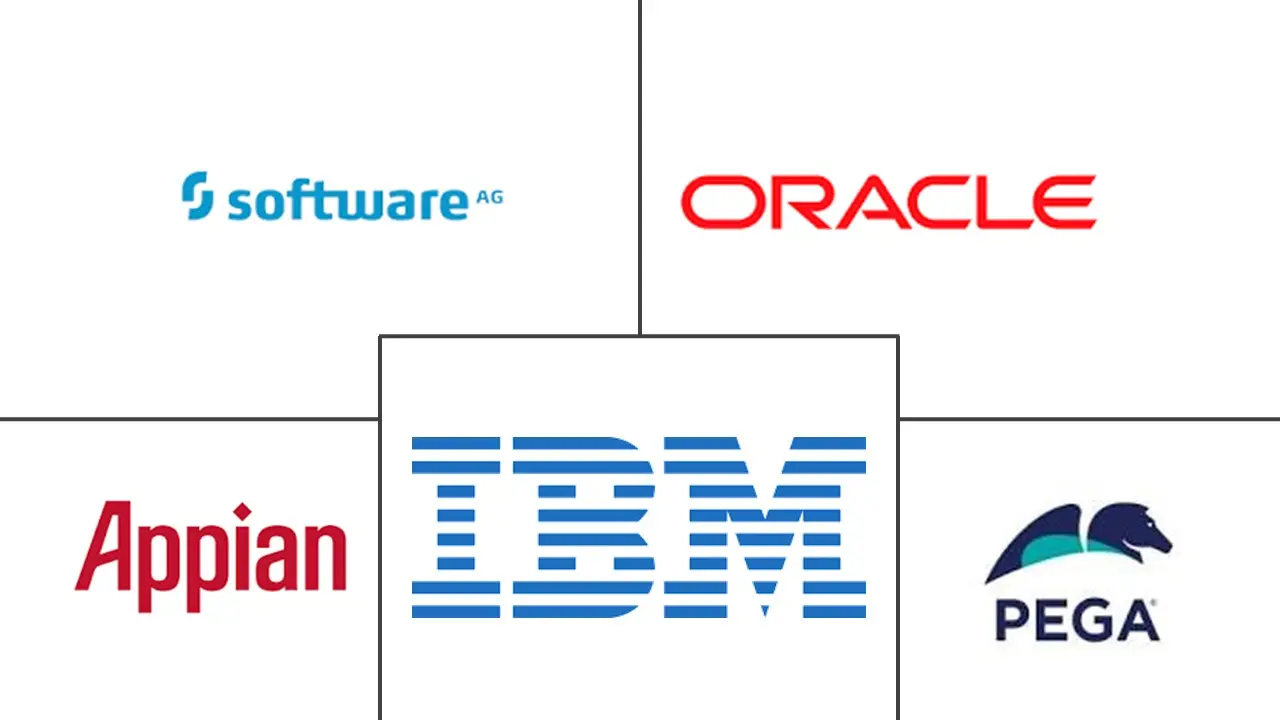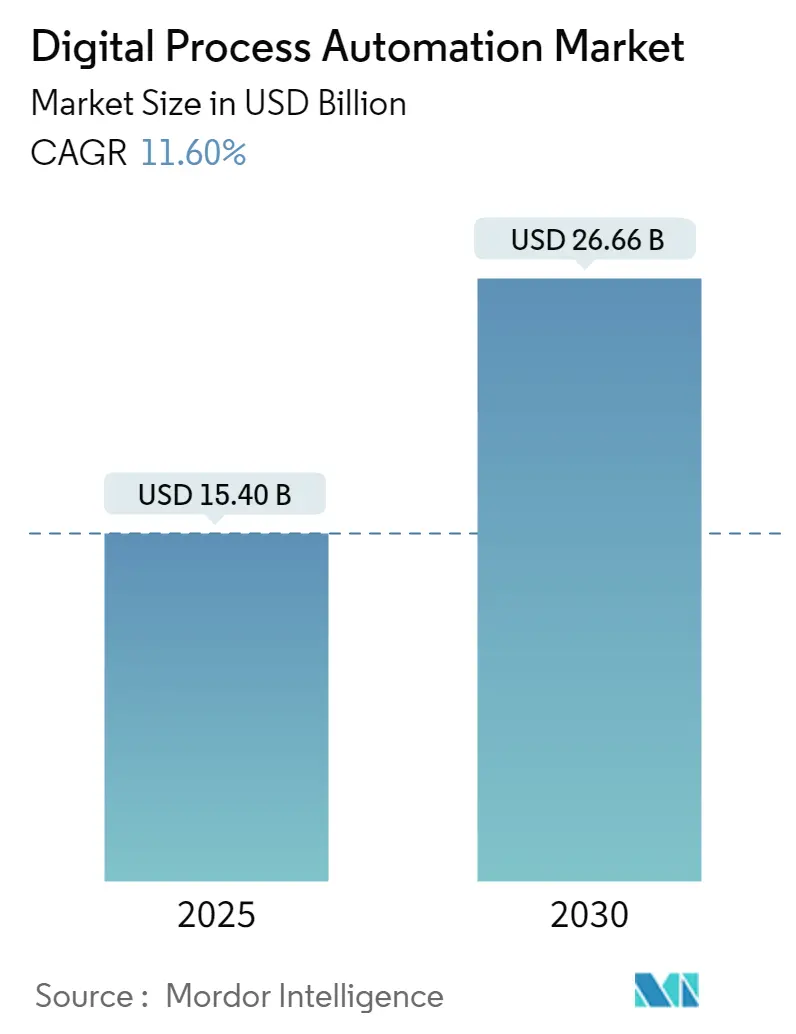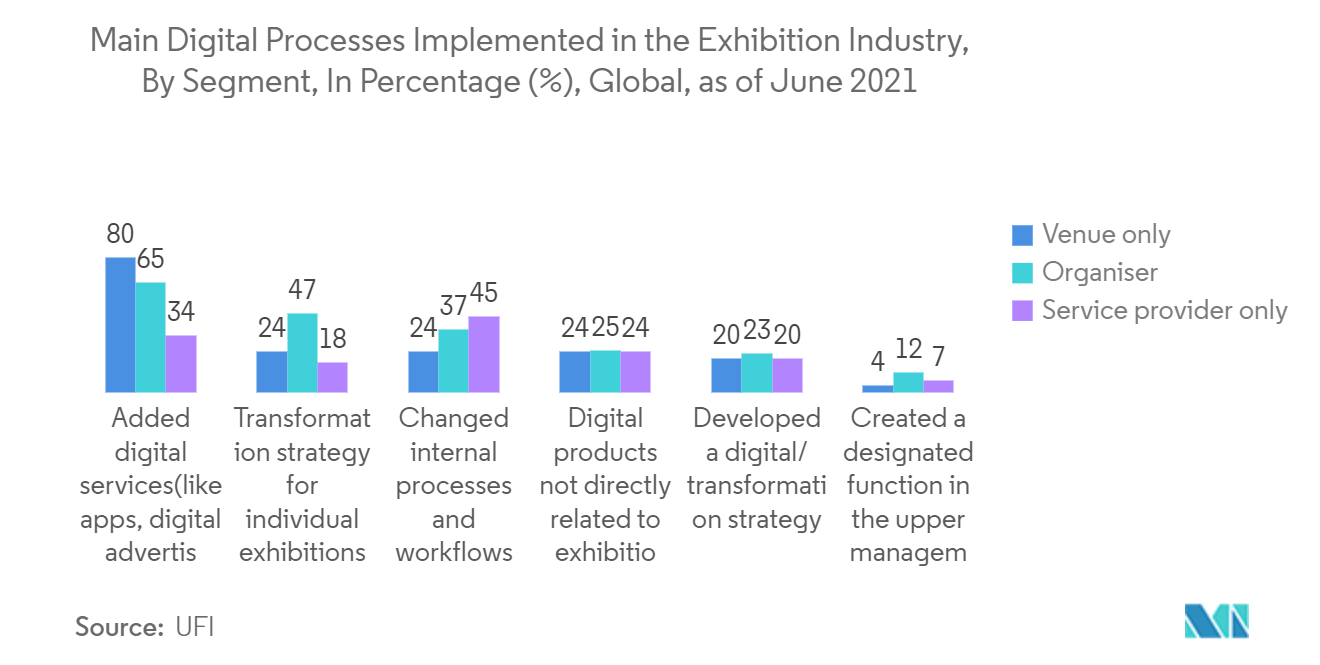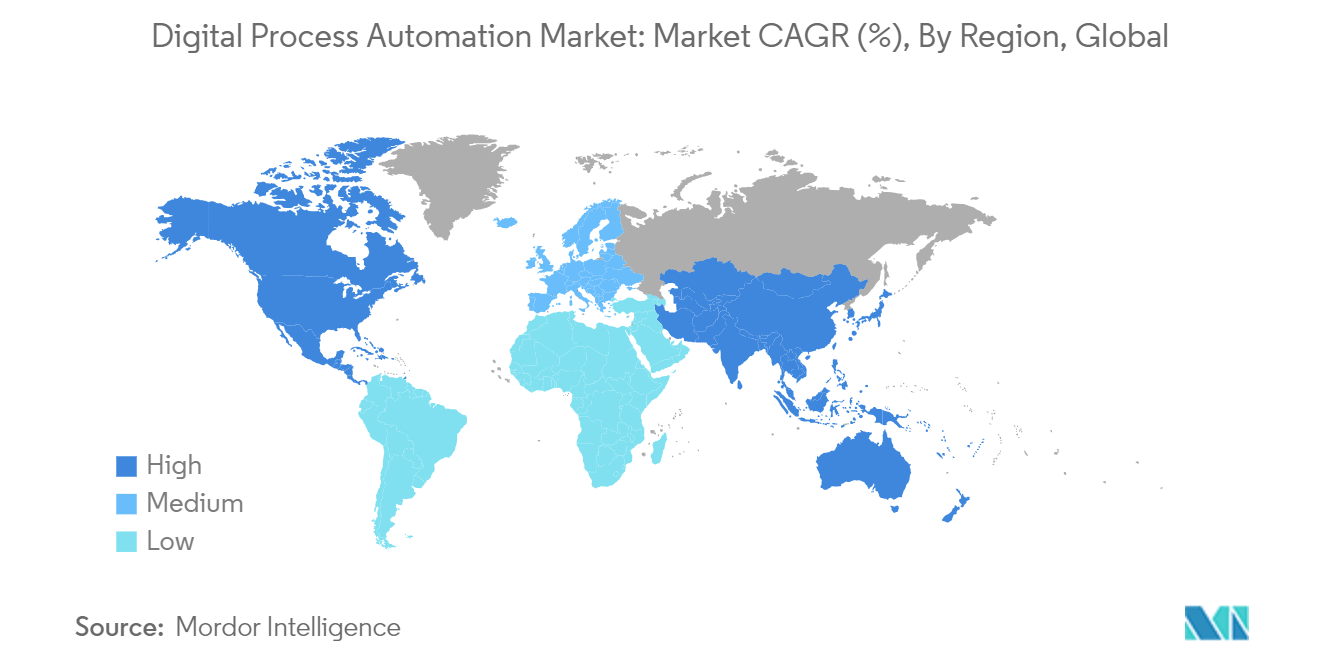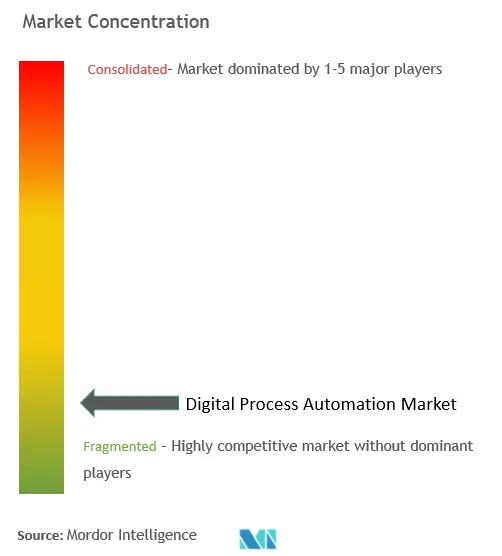Digital Process Automation Market Analysis
The Digital Process Automation Market size is estimated at USD 15.40 billion in 2025, and is expected to reach USD 26.66 billion by 2030, at a CAGR of 11.6% during the forecast period (2025-2030).
As new technologies are trending and accelerating, merging the virtual and physical worlds creates new business models. Manufacturers are introducing new business models under which they sell digital services and products, such as digital twins.
- Improving operational effectiveness and simplifying business processes are top priorities for organizations across all industries. According to inference, this emphasis on efficiency drives the demand for DPA solutions. By automating and optimizing manual and repetitive tasks, firms may lower errors, get rid of bottlenecks, and boost process efficiency. Organizations can achieve faster turn-around times, increased productivity, and cost savings by automating workflows and standardizing processes. The need for DPA solutions is anticipated to increase as companies look to enhance client experiences, drive operational excellence, and maintain their competitiveness in a changing market.
- Another significant market driver for DPA solutions is organizations' continual digital transformation path. According to inference, businesses are embracing digital technology at a faster rate to revolutionize their operations, improve consumer experiences, and gain a competitive advantage. By enabling organizations to digitize and automate their fundamental business activities, DPA plays a crucial part in this shift. DPA solutions enable organizations to achieve end-to-end process automation and agility by automating manual operations, linking systems and applications, and offering real-time visibility into process performance. The need for DPA is fueled by organizations' need to utilize digital technology and attain operational digital maturity.
- Legacy systems and complex IT environments can pose a significant restraint on the adoption of DPA solutions. Inference suggests that many organizations have existing systems, applications, and technologies in place that are not designed to easily integrate with DPA platforms. These legacy systems may lack the necessary APIs (Application Programming Interfaces) or modern architecture to seamlessly connect with DPA solutions, making integration challenging and time-consuming. Additionally, organizations may have heavily customized or proprietary software that is not easily compatible with off-the-shelf DPA tools.
- While the pandemic drove increased adoption of DPA solutions in many sectors, it also introduced budget constraints and shifting priorities for some organizations. Inference suggests that businesses heavily impacted by the pandemic may have diverted resources to address immediate challenges, such as cost-cutting measures or focusing on essential operations. This could have slowed down the adoption of DPA solutions or led to delays in planned projects. In addition, organizations that experienced financial difficulties may have limited budgets for investing in new technologies, including DPA. There has also been an impact of the Russia-Ukraine war on the overall packaging ecosystem.
Digital Process Automation Market Trends
Small Enterprises are expected to grow at a higher pace on back of growing adoption of Business Process Management (BPM)
- The adoption of BPM solutions helps organizations gain a better understanding of their existing business processes and identifies areas for improvement. Inference suggests that as organizations implement BPM initiatives, they become more aware of the benefits of process automation and optimization. This awareness creates a demand for DPA solutions as organizations recognize the need to automate their processes to achieve greater efficiency, productivity, and agility.
- BPM solutions frequently act as the cornerstone for digital transformation initiatives, helping businesses to integrate and streamline their operations across many divisions and platforms. Inference implies that when businesses embrace BPM, they become more aware of the benefits of complete process orchestration and automation. This insight increases demand for DPA systems that can easily link with BPM platforms, extending automation capabilities and giving businesses access to a whole automation ecosystem.
- BPM initiatives often involve scaling and adapting processes to meet changing small business needs and market dynamics. Inference suggests that organizations recognize the importance of scalable and flexible automation solutions to support their BPM efforts. DPA solutions offer the scalability and flexibility required to automate a wide range of processes, from simple to complex, and accommodate evolving business requirements. The adoption of BPM drives the demand for DPA solutions that can scale and adapt to support the organization's growing automation needs.
- BPM fosters a culture of continuous process improvement, encouraging organizations to regularly evaluate and enhance their processes. Inference suggests that as organizations embrace BPM, they seek automation solutions that support their continuous improvement efforts. DPA solutions enable organizations to monitor, analyze, and optimize their automated processes, driving efficiency gains and performance improvements over time. The adoption of BPM fuels the demand for DPA solutions that facilitate ongoing process improvement and provide analytics and insights for data-driven decision-making.
- During the coronavirus (COVID-19) epidemic, exhibition companies globally stopped some in-person events in 2020 and 2021 in favor of exploring digital formats. According to research conducted in June 2021, 80 percent of global exhibition venues incorporated digital services or products to complement their existing displays. Meanwhile, 45 percent of service provider organizations questioned converting internal procedures and workflows into digital processes.
North America to Account for a Significant Market Share in the Market
- Due to the region's large digital process automation vendors, North America is expected to contribute significantly to market expansion. The major trends responsible for the growth of the digital process automation market in the region include the diverse packaging that increases demand for advanced sensing technology, which will directly impact the increase of automated products.
- The United States is significantly growing due to improved technology and streamlined global supply chains/logistics. This emergence of international logistics networks means that United States manufacturers can now efficiently and effectively deliver the finished products and raw materials anywhere around the world.
- The region has witnessed a surge of partnerships, mergers, and acquisitions to capitalize on these possibilities. The fundamental driver of these investments has been the continued growth of new technologies and deployment options.
- In August 2022, Sigma Solve, a technology consulting and software development company that guides clients' visions for digitization, sales growth, system integration, and business process automation, has formed a strategic partnership with Liferay DXP, which will provide a feature-rich platform that puts integrated digital capabilities and innovation in the hands of businesses across North America. Sigma Solve's digital transformation approach integrates perfectly with Liferay's DXP platform.
- This trend has massively increased the economic opportunities of US manufacturers and international competitors. Robotic process automation (RPA) is one key technology enabling companies to address the fast pace of change across all business areas. RPA provides virtual agents to automate tasks, processes, and workflows for complex work.
Digital Process Automation Industry Overview
The digital process automation market is fragmented. New product launches and focuses on continuous technology innovations are some strategies adopted by the major players. Key players are IBM Corporation, Pegasystems Inc., Appian Corporation, Oracle Corporation, etc. Recent developments in the market are
- March 2023 - Leading network provider in Egypt, Telecom Egypt (TE), announced that it is collaborating with IBM to integrate intelligent automation technologies to provide a unified solution for all of its operations support systems (OSS) across mobile, fixed, and core networks. The use of IBM Cloud Pak for Watson AIOps running on RedHat OpenShift and the implementation of IBM Robotic Process Automation (RPA) solutions by TE are both planned. The solution will be created to give TE a complete picture of its whole IT infrastructure and to assist them in fast innovating, lowering operational costs, and reducing the amount of time needed to troubleshoot and resolve network-related events.
- February 2022 - A global cooperation between Nokia and Atos was launched to offer enterprises industry-leading 4/5G private wireless networking solutions, along with related digital services, and to collaborate on the creation of new, cutting-edge services. By facilitating new working methods, our cooperation will assist businesses in achieving increased operational efficiency. The combined product, which is hosted on servers from Atos or Nokia, combines the strengths of the two industry leaders in edge and cloud computing to support businesses as they transition to the 4.0 industrial revolution. The partnership makes
use of the Atos AI computer vision platform, which has recently been strengthened by Atos' acquisition of the AI pioneer Ipsotek and its unmatched IP and software capabilities, as well as the industrial-grade private wireless connectivity and application platform Nokia Digital Automation Cloud (DAC).
Digital Process Automation Market Leaders
-
IBM Corporation
-
Pegasystems Inc.
-
Appian Corporation
-
Oracle Corporation
-
Software AG
- *Disclaimer: Major Players sorted in no particular order
Digital Process Automation Market News
- July 2022 - Oracle Fusion Sales, a sales automation tool that locates high-quality sales opportunities and helps sellers close deals more quickly, has just received an update, according to Oracle. Fusion Sales is an artificial intelligence (AI)-driven component of Oracle Fusion Cloud Customer Experience (CX) that automatically offers sellers prices, recommendations, and suggested next steps in order to help them close more deals, work more productively, and inspire trust in their customers.
- May 2022 - To work together on business process automation, Digital Workforce formed a relationship with the Swiss enterprise Flowable. In a recently released updated plan, Digital Workforce stated its ambition to create the Outsmart platform for fully automated business processes. For the creation and management of intricate, end-to-end business processes, Outsmart will provide all the necessary skills. To enable process orchestration, automated task processing, and the coordination of work done by humans and work done by software robots or AI, Outsmart will use industry-leading, best-of-breed technologies, such as Flowable.
Digital Process Automation Industry Segmentation
Digital process automation uses digital technology to perform a process or accomplish a workflow or function. The main drivers for the market include the integration of Artificial Intelligence (AI) and Machine Learning (ML) technologies. Businesses worldwide have relied on business process management (BPM) to enhance and manage the back-end activities efficiently and on the processes, such as retail lending, customer onboarding, customer support, etc.
The digital process automation market is segmented by component (solution, service), deployment (on-demand, on-premises), organization size (small- and medium-sized enterprises, large enterprises), end user (banking, financial services, and insurance (BFSI), manufacturing, IT and telecommunication, aerospace and defense, healthcare, retail, and consumer goods), and geography (North America, Europe, Asia-Pacific, Latin America, and Middle East & Africa). The report offers market forecasts and size in value (USD) for all the above segments.
| By Component | Solution |
| Service | |
| By Deployment | On-demand |
| On-premise | |
| By Organization Size | Small- and Medium-sized Enterprises |
| Large Enterprises | |
| By End User | Banking, Financial Services, and Insurance (BFSI) |
| Manufacturing | |
| IT and Telecommunication | |
| Aerospace and Defense | |
| Healthcare | |
| Retail and Consumer Goods | |
| Other End Users | |
| Geography | North America |
| Europe | |
| Asia Pacific | |
| Latin America | |
| Middle East and Africa |
Digital Process Automation Market Research FAQs
How big is the Digital Process Automation Market?
The Digital Process Automation Market size is expected to reach USD 15.40 billion in 2025 and grow at a CAGR of 11.60% to reach USD 26.66 billion by 2030.
What is the current Digital Process Automation Market size?
In 2025, the Digital Process Automation Market size is expected to reach USD 15.40 billion.
Who are the key players in Digital Process Automation Market?
IBM Corporation, Pegasystems Inc., Appian Corporation, Oracle Corporation and Software AG are the major companies operating in the Digital Process Automation Market.
Which is the fastest growing region in Digital Process Automation Market?
Asia Pacific is estimated to grow at the highest CAGR over the forecast period (2025-2030).
Which region has the biggest share in Digital Process Automation Market?
In 2025, the North America accounts for the largest market share in Digital Process Automation Market.
What years does this Digital Process Automation Market cover, and what was the market size in 2024?
In 2024, the Digital Process Automation Market size was estimated at USD 13.61 billion. The report covers the Digital Process Automation Market historical market size for years: 2019, 2020, 2021, 2022, 2023 and 2024. The report also forecasts the Digital Process Automation Market size for years: 2025, 2026, 2027, 2028, 2029 and 2030.
Our Best Selling Reports
Digital Process Automation Industry Report
Statistics for the 2025 Digital Process Automation market share, size and revenue growth rate, created by Mordor Intelligence™ Industry Reports. Digital Process Automation analysis includes a market forecast outlook for 2025 to 2030 and historical overview. Get a sample of this industry analysis as a free report PDF download.

